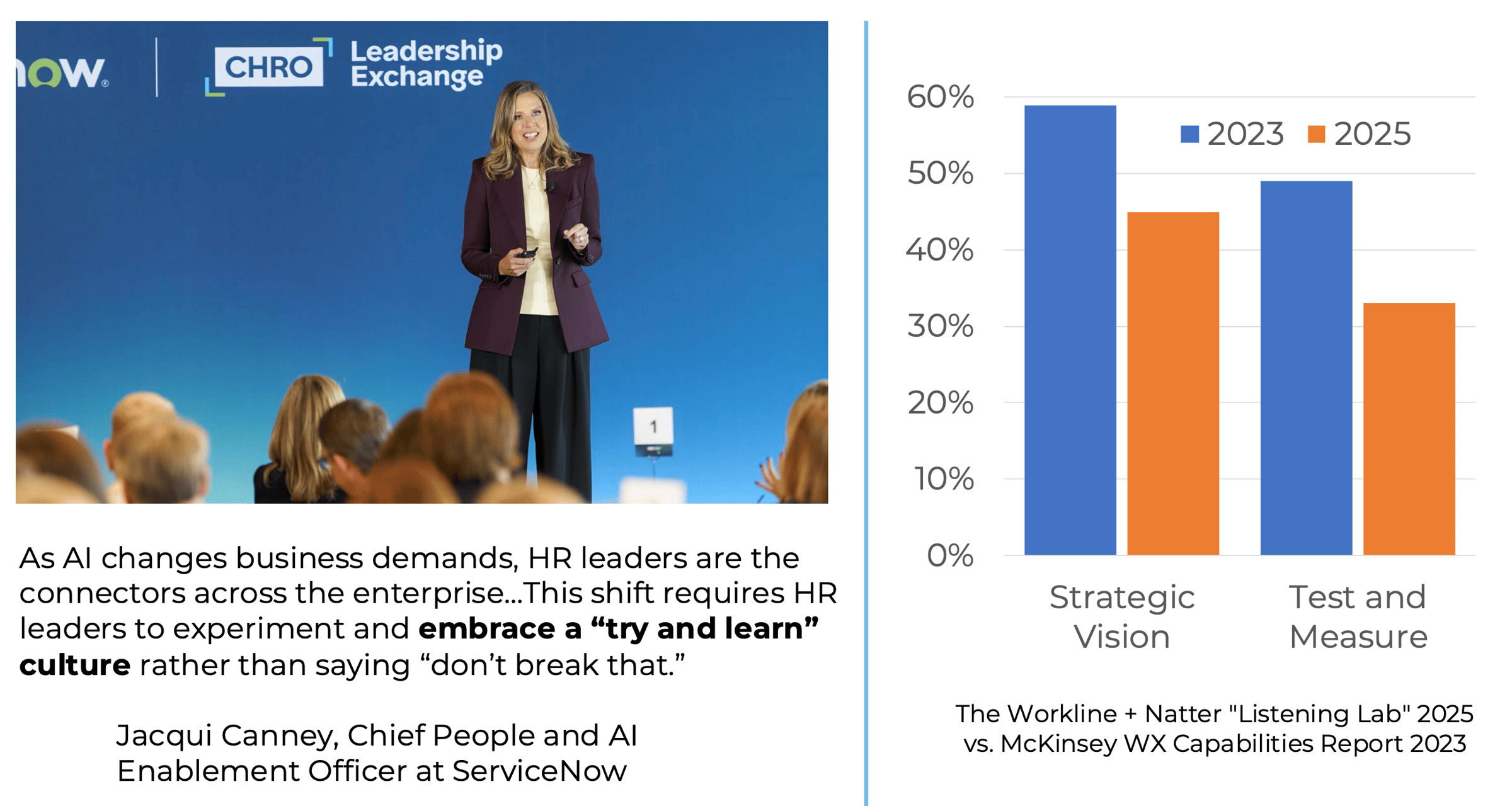The Case for Cross-Functional Courage

Why Courage Beats the Org Chart
When asked to moderate a “State of the Industry” panel at WorkSpaces, I agreed on the condition we could make it a “State of the Organization.” Corporate real estate departments are notoriously hard to benchmark, partly because they can be positioned almost anywhere on the org chart.
I polled the audience to start: Who reports to finance? About 40%. How about HR? About one-third. IT, Legal, or Operations? A few hands each.
My fabulous panelists supported the hypothesis beautifully:
- Lynn Baez (McKesson, like Drew) sits in Treasury under Finance.
- Frederico (“Fred”) Egli (IBM) also sits in CFO, but via Operations.
- Erica Chapman, had six different bosses across COO, CHRO, and Procurement organizations in as many years at PepsiCo.

Organizational Whac-a-Mole affects every function touching employee experience. HR inherits culture mandates without the space budget; IT specs the screens in rooms built by CRE. Unpredictable reporting across shared services causes fragmented decision-making.
However, this organizational chaos is not the most challenging part for workplace leaders trying to maximize effectiveness and influence.
Lead Across the Lines of Modern Work with Phil Kirschner
Over 22,000 professionals follow my insights on LinkedIn.
Join them and get my best advice straight to your inbox.
The Authority Gap
Erica named a core dysfunction in CRE and other internal functions:
If you're going to say I have responsibility for the workplace, but I don't really get to make the decisions, that's incongruent with the ability to be truly successful.
Influence without authority is a critical skill; responsibility without authority creates theater, not transformation.
CRE leaders are often held accountable for outcomes they can't control. The traditional fix is the reporting structure, like finding a powerful sponsor or securing a seat at the table. But Erica's six bosses prove that stability is fleeting.
You can't wait for the perfect org chart. It's never coming.
Following the Money
Knowing workplace leaders can't always count on the boss to define and support portfolio transformation, Fred suggested a clever alternative:
Sending the bill is a powerful tool.
IBM allocates real estate costs to business units. While common, this model can make it difficult to reclaim or reallocate space for the good of the company without the willing participation of one department. Fred’s team is exploring the idea of a centrally-funded model so CRE approves or denies space based on enterprise value, not local revenue optics.

This change would actively redesign who pays for what to change organizational behavior, as I wrote in Below the Line. It's a bold move requiring CFO-level buy-in and challenges decades of precedent. But it also cuts through the authority gap faster than any org chart redesign.
Purpose Before Space
Going one step further than financial incentives, Lynn suggests that workplace leaders start with purpose rather than cost allocation alone:
We've shifted a lot of our business cases to support purpose as the first intent. So if we are going to adjust cultural norms, cultural behaviors, intended goals and outcomes, that's where we start and then we build the model around it.

Instead of "we need X square feet for Y headcount," McKesson’s real estate conversations now begin with "we want to enable casual collisions and cross-team innovation."
This doesn't eliminate costs; it redirects them. Collaborative goals require different spaces, terms, and success metrics, not to mention behaviors.
But purpose-led transformation requires governance through decision-making forums with clear authority and aligned budgets. Which brings us to the meeting problem.
👀 Will I see you in California next week? 👀
- CoDesign | October 21 | San Francisco ✈️ | Speaking 🎤
- Tradeline | October 22-23 | San Diego ✈️ | Speaking 🎤
Change Your Meetings Diet
Lynn shared that McKesson real estate has several critical meeting cadences, e.g., operational reviews, all-hands sessions, and co-branded engagement forums with business partners. These forums are where decisions get made with clear authority and aligned budgets.
But not all meetings are created equal, and Fred said what so many of us are feeling:
We have a lot of meetings and I hate them. I'm trying to avoid doing all those meetings as much as possible.
Fred shared an example of async communication: the CEO records a monthly monologue explaining where the company is going, which is essential for planning without another meeting.
Beyond reducing needless meetings, Erica shared fantastic advice for workplace leaders: “The best meeting is one that's not about real estate...Get in those meetings whether or not you're invited.”
Erica states she "never makes real estate recommendations—only business recommendations involving space." In a major consolidation project, she presented both the financial and emotional business cases, noting a leader wanted to be in a specific market, even if it wasn’t the most cost-effective.
Practice in Peacetime
Lynn highlighted an often-overlooked aspect in portfolio discussions: resilience during times of change. McKesson shrunk their office portfolio by 60% while navigating M&A and divestitures. Such agility is impossible when every space decision requires negotiating with local leaders.
But here's the catch: most organizations struggle to handle even small-scale change, let alone merger integration.
In my recent listening lab with 50 workplace leaders, I discovered that more leaders now disagree than agree that their organizations can effectively “test and learn” in real estate.

If you can't test a new meeting room configuration at 10% scale, you certainly can't integrate two corporate portfolios at 100% scale.
Lynn emphasizes the importance of knowing who'll manage the money next and building flexible models that adapt faster than leases. During reorganizations, chargeback rules and decision rights are the quickest levers, long before exits and redesigns.
The organizations that survive constant change build test-and-learn muscles in peacetime, making dozens of small bets that inform big moves.

Set a Vision for Better Meetings!
Lost in a sea of too many and ineffective meetings? Look to the stars to inspire a change.
Talent for the Future
As my final question, I asked the panelists about talent pipelines: how future leaders enter CRE and whether they had access to campus recruiting programs.
Lynn said make it a vendor requirement. McKesson's outsourcing partner must recruit from college campuses and hospitality sectors. Internally, they pull ops talent from manufacturing.
Erica challenged leaders to expand their remit. Add sustainability, economic development, business continuity, security. Growing the scope grows the team and attracts different talent.
Fred's strategy: Hire internally first. Teach business-savvy employees real estate, not the reverse. We look externally for specialized, technical roles or when we’re unable to find the right talent internally.
All three show that addressing complex incentives and dynamic organizations requires prioritizing business problems over real estate. These shifts can't happen if your team is stuck justifying utilization data to leaders who cling to unused space.
Your Courageous Move
If you're ready to transcend org chart chaos and drive real change:
Get in business meetings. Stop talking utilization rates. Identify one leadership forum about growth, strategy, or transformation—and bring business metrics that matter to executives, not real estate metrics.
Audit your authority gap. Where are you accountable without decision rights? Identify one area with responsibility and authority mismatches, then move a budget line or establish a decision forum to close it.
Hire different talent. Look at your last three hires. All traditional real estate backgrounds? Expand your search to operations, hospitality, business strategy—people who think like partners, not order-takers.
When the org chart won't stabilize, these moves create influence faster than waiting for the perfect reporting structure.

Lead Across the Lines of Modern Work with Phil Kirschner
Over 22,000 professionals follow my insights on LinkedIn.
Join them and get my best advice straight to your inbox.


